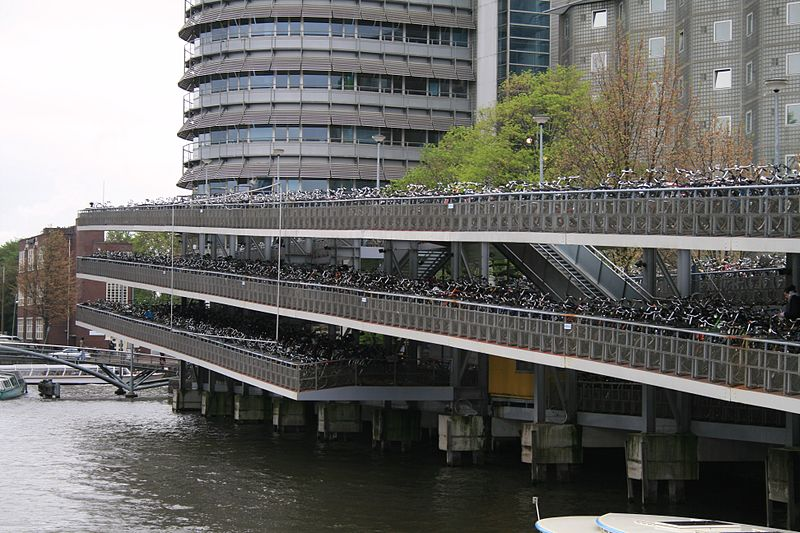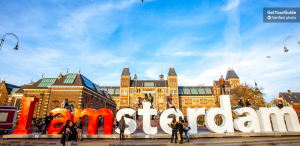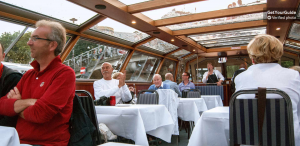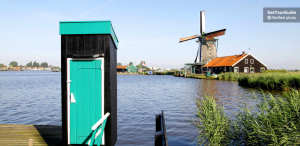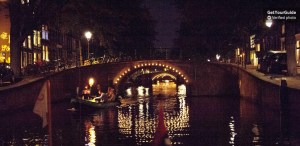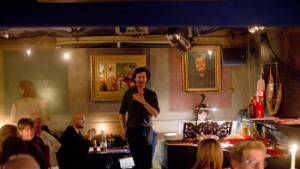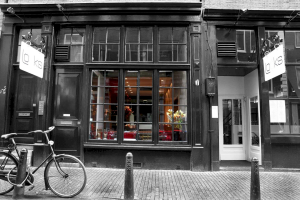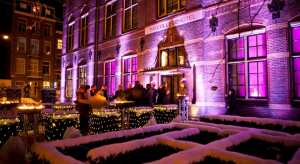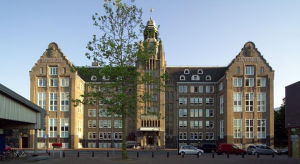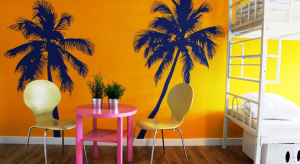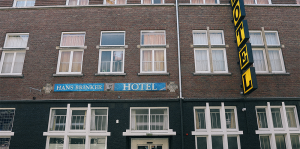By bicycle
A pleasant way to cover a lot of ground is to rent a bicycle. There is at least one bike for every one of the 800,000 people living in Amsterdam. The city is very, very bike-friendly, and there are separate bike lanes on most major streets. In the city centre, however, there is often not enough space for a bike lane, so cars and cyclists share narrow streets.
Cyclists do not have the right of way even though it might appear so when observing the typical Amsterdammer’s cycling behaviour (see Extra legal protection). Be very careful to watch out for other cyclists. Always show other traffic where you’re going (e.g., by holding out your hand) in order avoid accidents and smooth the traffic flow. If not indicated otherwise by signs, the right-before-left rule applies. Avoid getting your tyre in the tram rails; it’s a nasty fall. Always cross tram rails at an angle. When crossing tram lanes, watch out for fast approaching taxis. They have a rather ruthless driving style. Let none of the above deter you from doing it the Amsterdam way. Be advised, however, that cycling the Amsterdam way takes a significant amount of skill: the locals have been riding bikes from the moment they could walk and this informs their behaviour. If you don’t feel entirely comfortable on a bike, it may be a stressful affair rather than the smooth ride you may imagine it to be. On top of that, if your lack of confidence makes you block pathways used by other people who can skilfully manoeuvre along them (e.g. groups of people, between stationary vans and the rows of bollards dividing street and footpath), who have appointments to make and jobs to attend, it can create tensions between you and locals. If you don’t feel entirely comfortable on a bike, walk! It’s less stressful, and Amsterdam is so small the entire city centre can be navigated on foot within half an hour.
A good map for cycling (routes, repairs, rentals + also public transport) is Amsterdam op de fiets (a Cito-plan). When preparing a route, there’s a digital bicycle route-planner for Amsterdam.
Bicycles can be taken on all metros and tram 26 using the bike supplement fee (€1.60 in 2012) on the OV chipcard. Use the special bike racks, locations indicated by a bicycle sign on the outside of the carriage.
Bicycles (and scooters) can be taken for free on all ferries across the IJ.
Make sure to get a good lock (or two), and to use it. Amsterdam has one of the highest bicycle theft rates in the world, see the Netherlands page. Note also that, if buying a bike, prices that seem too good to be true are stolen bikes. Any bike offered for sale to passers-by, on the street, is certainly stolen. There’s an old Amsterdam joke; When calling out to a large group of cyclists passing by; “Hey, that’s my bike!” about five people will jump off “their” bikes and start running.
If you are as good a cyclist as the locals, rent a bike! There are bike rental shops at stations, and several others in and around the city centre. Bikes cost about €9 to €20 per day. (Bring wet gear.)
Public transportation
In June 2010, a contactless card called OV-chipkaart (“public transport chip card”) was introduced. Since 3 June 2010, the old ‘strippenkaart’ system has been abandoned on all forms of public transport in Amsterdam, making the chipkaart the only valid way of travelling in Amsterdam. To travel with a card, one has to check in at the start of the journey and check out at the end by holding the card in front of the card reader.
Three types of OV-chipkaart are available:
a personal card on which you can load weekly/monthly/yearly subscriptions
an anonymous card on which you can load money which can be spent on public transport
a disposable card which can be used for a limited number of hours only
The first two types carry a fee of €7.50 for the card itself, and you have to have at least €4 on it to be able to travel. The OV-chipkaart can be obtained from GVB vending machines in all metro stations, from the desks at some bigger stations (including Centraal Station) and some shops (see [http://www.gvb.nl/reizigers/ovchipkaart/Pages/Ophalenenopladen.aspx this map).
For visitors, the most useful type of travel pass is probably the 1/24/48/72/96/120/144/168 hour ticket, issued as a disposable OV-card without extra cost. This allows the holder to travel on an unlimited number of journeys on tram, metro and GVB bus services throughout the validity period of the pass. On a tram, only the 1 and 24 hr tickets can be purchased on board. These passes are also available at tourist offices (located at Schiphol airport and just outside Centraal Station), AKO bookstores in Schiphol Airport and Centraal Station, many hotels and GVB Tickets & Info. Day passes are not valid on buses operated by Connexxion and Arriva.
Prices as of Jan 2012: €7.50/24 hours, €12/48 hours, €16.50/72 hours, €21/96 hours, €26/120 hours, €29.50/144 hours and €32/168 hours. If you stay longer in Amsterdam, you can buy discounted weekly or monthly tickets from most post offices or other ticket sale points which are cheaper. GVB tickets are not valid on trains to Schiphol airport. You can use them on buses to Schiphol (note: The only GVB bus that goes to the airport is number 69) but it’s usually quicker to get there by train. For current information on the Dutch Public Transportation-system (‘Openbaar Vervoer’ or O.V. in Dutch/NL) check online Openbaar Vervoer (O.V.).
Tram
Public transport within the city is operated by the GVB (Gemeentevervoerbedrijf. The tram (16 lines) is the main form of public transport system in the central area, and there are also dozens of night bus routes which run in place of the trams between midnight and 5am. All tram stops have a detailed map of the system and the surrounding area. You can also get a free public transport map at the GVB Tickets & Info offices (just outside Centraal Station) or in the tram.
Most trams have conductors, near the rear of the tram. Board (and obtain tickets if necessary) by the driver or the conductor. If you have questions, the conductor or driver will be sure to respond to your query. Remember that you can only buy 1h and 24h tickets on board the tram.
When boarding and alighting a tram, you must check in and out by placing your ticket/OV-chipkaart on one of the abundant round-shaped readers, even if you have just bought a ticket on board. All trams have pre-recorded audio announcements indicating the next stop, with most also having visual indication. All announcements on board are in Dutch, however some announcements (such as those indicating termini and important stops (such as Dam Square) and reminders to check out when alighting the tram) are also in English.
Metro
Amsterdam Metro/Sneltram Map
There is a four line metro, including a short underground section in the city centre, that serves the neighbourhoods of the South East. It takes 15-20min from Centraal Station or Waterlooplein to the Bijlmer (Amsterdam Arena stadium, Heineken Music Hall and Pathe Arena cinema and IMAX).
A fifth metro line, the north/south line, is currently under construction and is due to be opened in 2017. This big project started in 2003 to build a new underground metro line to connect the north of Amsterdam with the south (the Noord/Zuidlijn or North/Southline). The project has proved somewhat of a disaster for the city government with big budget overruns and delays. Building in the wet underground of Amsterdam is difficult and some buildings along the line have sustained damage due to subsidence. For the visitor to Amsterdam, the only thing to note are the ongoing roadworks along the route of the metro line. Underground metro stations are still being built or finished often causing parts of roads to be blocked off to cars, buses and trams for an extended time. Usually you can pass on foot or bicycle.
Bus
Just like the tram and metro, local buses are operated by the GVB. There are also suburban buses to nearby towns such as Haarlem and Uithoorn; these are operated by Connexxion or EBS (the company name and house style is prominent on the bus side) and can be used within Amsterdam if you travel with an OV-chipkaart. Disposable cards are only valid on the GVB buses.
By boat
There are several free ferry services across the IJ river, to Amsterdam North, the most frequent runs every 7min. They all leave from a new jetty on the northern (rear) side of Centraal Station. The nicest one is the 15min service to NDSM Werf, a funky up and coming industrial neighbourhood with a nice cafe-bar (IJkantine), restaurant (Noorderlicht) and indoor skateboard park (Skatepark Amsterdam). In addition, the Pancake Boat (Pannekoekenboot) sails many times each week from the NDSM Werf. Ferries leave every 30min from Centraal Station and from NDSM Werf. Double frequencies during rush hours. Another boat company to discover Amsterdam is Canal Company, which offers a large selection of canal cruises. You can choose between the classic canal cruises, open boat tours, canal bikes or evening cruises in several variations.
By rental scooter
There are several scooter rent shops in the city centre of Amsterdam. Gilex scooter rental, Scooter Rent Amsterdam, AmsterBike, Boka Scooter Rentals and Left Bank Scooters Rentals & Tours are just a few examples.
By taxi
New guidelines were introduced in June 2013 to bring down the bad cab drivers. Many new companies were founded and bad companies failed. Amsterdam needed these guidelines to help the taxi branche.
Try avoiding the taxi stands at Central station and Leidseplein. Some drivers, traditionally at Centraal Station or Leidseplein, will refuse short trips or will quote outrageously high fares, even though all taxis are metered. Even if you convince the driver to use the meter, he will often take a circuitous route that racks up €15 or more on the meter. For reference, no trip within the historic centre should cost more than €10 or so. If you want to avoid these circumstances try pre-booking at a company like Deluxe Taxi Amsterdam
Regular taxi price have the following rates: Start: €2,89 per km: €2,12 per min:€0,35 (jan 2014) all taxis have a meter which will calculate the price. You can also go for a fixed rate but it’s recommended to follow the meter if the right route has been taken by the driver you will pay as it should be.
Unlicensed, illegal, cabbies operate mainly in Amsterdam Zuidoost, Leidseplein crossing Prinsengracht and at the Rembrandt Square. These aren’t easily recognized as such, and most certainly don’t drive Mercedes cars. They are known as snorders and most easily reached by mobile phone. Rides within Amsterdam Zuidoost (the Bijlmer) range from €2.50 to €5, whereas Zuidoost-Centre can run up to €12.50. Snorders have a bad reputation, so never consider their services! because if anything happens you are not insured!
By car
It is practical to use a car only outside of the historic centre; within the historic centre, the traveller is advised to stay with public transport. In Amsterdam, a car is generally a liability and not an asset. Use a car only if you are going to an obscure location many miles out that is not served by public transport.
Driving around Amsterdam is a pain: many of the streets are narrow, the traffic (and parking) signs are baroque and obscure, and cyclists and pedestrians may get in your way. Plus, petrol is about 1.54€ to 1.7€ per litre. You can try parking at one of the secured parking garages, for example under Museumplein, or near the Central Station, and then walk around the city centre, or use a tram. Car parking is very expensive in Amsterdam and it’s often hard to find a place to park. You can choose to pay by the hour or for the whole day. Parking is free outside the centre on Sunday. There is always a spot available on the Albert Cuypstraat (which is a market during the rest of the week). From there, it is a 5 minute tram ride or 15 min walk downtown.
Another option is to park your car further outside the city-centre. For 8€,- you get a full day (24 hr) of parking and a return ticket downtown. The ride takes about 15 minutes. Look for the P+R (Park and Ride) signs. [11]
You can also park for free in some parts of Amsterdam outside the city centre though this may be slowly changing. Parking is still free everywhere in Amsterdam-Noord, and you can just take the bus from the Mosplein stop to the city centre easily. Plenty of buses run through here.
Popular car rental chains operate in a smaller capacity in Amsterdam, including Avis and Budget Rent a Car. Most recently ‘Car 2 Go’ has all-electric Smart cars availible within and around the city.


